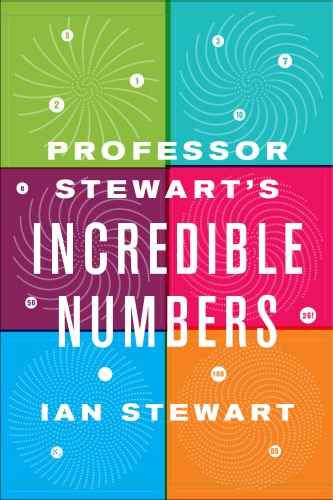
Professor Stewart's Incredible Numbers
- اطلاعات
- نقد و بررسی
- دیدگاه کاربران
نقد و بررسی

May 18, 2015
Stewart (In Pursuit of the Unknown: 17 Equations That Changed the World), emeritus professor of mathematics at the University of Warwick (U.K.), puts the "digit" in prestidigitation in this delightful and wholly absorbing book on the magical world of numbers. He begins with the most basic concepts and spirals out into some of today's most exciting mathematical theories; his effective mix of history and math lessons helps keep readers engaged with the mathematical concepts. Stewart's discussion of zero is particularly fun as he shows how civilizations throughout history each came to terms with the necessity of calling zero a number. His own enthusiasm for the subject is clear, and the inventive organization lets readers follow him on his own path through numbers, though experienced math book readers might find it more exciting to skip around. Whether writing about the importance of prime numbers or the ubiquity of fractals in nature, Stewart always seems to find a way back to one underlying concept: numbers are simple at their core, yet limitless in their utility. Agent: George Lucas, InkWell Management.

February 1, 2015
The erudite British math professor revels in the wonders of numbers.Stewart (Emeritus, Mathematics/Univ. of Warwick; The Mathematics of Life, 2011, etc.) adopts the framework of the chapters as subjects to elucidate the charms of the digits one to 10, adding separate chapters for special numbers including zero, negative numbers, rationals and irrationals, pi, e, the imaginary number i (the square root of minus 1) and so on. For each, the author provides historical context-e.g., many 19th-century mathematicians found the notion of infinity abhorrent. Stewart's approach works well early on, giving a nice sense of how math has evolved to ever larger number systems that have many applications beyond pure mathematics. However, Stewart tells about the remarkable findings of great mathematicians rather than showing how they were obtained. This is partly because the proofs involved are too complex or technical, requiring some knowledge of calculus or complex numbers. Yet even in simpler cases where Stewart shows steps in a proof, his explanations are terse and may assume too much on the part of readers. (On the other hand, he is expansive in giving the names and dates of those who carried out calculations of the square root of 2 or pi to a zillion places.) The degree of sophistication grows in the latter half of the text, as Stewart discourses on fractals, musical scales, packing problems, Rubik's cubes, string theory and encryption, including an analysis of the celebrated German enigma code of World War II. The topics defy any logical sequence, so a discussion of wallpaper patterns can be followed by the famous birthday problem in which it turns out that the probability of two people in a group having the same birthday is greater than 50 percent in a group as small as 23 people. Stewart receives an A for telling us how vast, wonderful and useful are all the members of the world of numbers but a lower grade for his explanation of the whys and wherefores.
COPYRIGHT(2015) Kirkus Reviews, ALL RIGHTS RESERVED.




دیدگاه کاربران